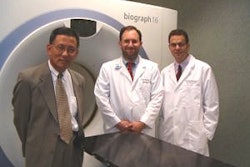
By Joseph Hawkins, CEO
Merritt, Hawkins & Associates
There’s good news and bad news for radiologists on the recruiting front. The good news is that you're no longer being hunted like the last unicorn in the forest. You may still find plenty of recruitment letters in your mailbox, but recruiting firms won’t be killing quite as many trees in an effort to reach you.
The bad news is that you're no longer number one on the list of hot doctors. According to Merritt Hawkins & Associates' 2004 review of physician recruitment incentives, orthopedic surgeons, not radiologists, are now the most in-demand physicians in the U.S.
Each year our firm reviews approximately 2,500 assignments performed on behalf of hospitals, medical groups, and individual doctors across the U.S. For the three years prior to the 2004 review, radiologists had been the firm's most-requested recruitment assignment.
In fact, the appetite for radiologists became truly ravenous over the last several years, harkening back to the crunch in primary care recruitment that occurred in the mid-1990s, when hospitals and medical groups everywhere were desperate for "gatekeepers." But the zeal for radiologists may have eclipsed even the Great Primary Care Craze of the 1990s.
The rising demand for radiologists was clearly reflected in the average income offers made to recruit them. Low-, average-, and high-income offers in radiology were tracked in MHA's last four recruitment incentive reviews as follows:
| Recruiting incentives for radiologists (salary or income guarantee) excluding bonuses and all other incentives | |||
| Year | Low | Average | High |
| 2001 | $200,000 | $271,000 | $500,000 |
| 2002 | $240,000 | $286,000 | $600,000 |
| 2003 | $230,000 | $317,000 | $500,000 |
| 2004 | $240,000 | $336,000 | $450,000 |
It's interesting to note that while the number of recruitment assignments for radiologists declined from 230 in 2003 to 210 in 2004, indicating a diminution in demand, average income offers actually increased from $317,000 to $336,000, a growth rate of 6%.
This is not uncommon in the physician recruiting cycle, in which income offers often play catch-up with demand. It generally takes a while for rising demand to be felt throughout the market, at which point income offers rise. It also generally takes a while for the decreased demand to filter through to the market. As a result, income offers can continue to rise while demand subsides. That was the case in radiology over the past year. I believe that income offers in radiology have peaked -- particularly at the higher end of the scale. Offers of $400,000 and up, which had been relatively common in the last several years, are becoming somewhat rare.
In addition, the generous vacation packages being offered to radiologists, with 12 weeks being pretty common and up to 17 weeks not unheard of, are being scaled back somewhat. So a certain sense of reality and proportion has returned to radiology recruitment.
Nevertheless, plenty of hospitals and medical groups are still eager for the services of radiologists, and I do not foresee this changing anytime soon. The expanding applications of imaging, and its noninvasive nature -- along with the overall population growth, and the population growth among the elderly in particular -- all ensure that radiologists will be in demand for the long term.
Seen in this light, the recent slowdown is simply part of the recruitment cycle. Many providers have made radiology a recruitment focus over the last several years, to the exclusion of other needs. Like the Dutch boy in the story, some have plugged one leak in their staffs (radiology) and now must get busy plugging other leaks, such as orthopedic surgery, cardiology, general surgery, etc. There was even a slight increase in the demand for family practitioners this year. But the fact remains that almost nothing can be done in healthcare today without an image, which ensures the high status of radiologists from a recruitment perspective for the next decade and beyond.
Other results of the 2004 MHA review may also be of interest. Of the 2,594 permanent recruitment assignments conducted, salaries were offered in 59% of the searches, income guarantees in 41%. Of the guarantees, 95% included a "forgiveness" clause in which any monies owed by the physician at the end of the contract period were forgiven in exchange for a commitment to stay in the community. Relocation was paid in more than 99% of the searches, with an average relocation allowance of $9,250. Signing bonuses were offered in 50% of the searches, with an average bonus of $15,500.
By Joseph HawkinsAuntMinnie.com contributing writer
July 26, 2004
Joseph Hawkins is CEO of Merritt, Hawkins & Associates, a national physician-search firm based in Irving, TX. A copy of the 2004 Recruitment Incentive Review is available at the MHA Web site. Hawkins can be reached at [email protected].
Related Reading
Survey predicts big loss of practitioners to retirement, changing work patterns, December 23, 2004
Salary offers to radiologists jump 11%, July 14, 2003
Radiologists tough to recruit, survey finds, February 25, 2003
Copyright © 2004 AuntMinnie.com



















